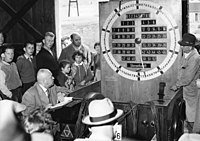
Photo from wikipedia
This paper studies first-best and second-best congestion pricing in the presence of unobserved and observed preference heterogeneity using a stylised stochastic user equilibrium choice model. Travellers choose between multiple alternatives,… Click to show full abstract
This paper studies first-best and second-best congestion pricing in the presence of unobserved and observed preference heterogeneity using a stylised stochastic user equilibrium choice model. Travellers choose between multiple alternatives, have heterogeneous values of travel times, and may differ in their valuation of variety. We derive first-best and second-best tolls taking into account how the overall network demand responds to expected generalized prices, including tolls. For second-best pricing, we show that with homogeneous values of times the welfare losses of second-best pricing are smaller when route choice is probabilistic than when route choice is deterministic. Furthermore, we find that with heterogeneous values of times and benefits of variety, uniform second-best tolls and group-differentiated tolls can be very close, implying potentially low welfare losses from the inability to differentiate tolls. Finally, we show that there are cases where all groups benefit from second-best congestion pricing, but that these cases are likely to be politically unacceptable because tolls are then higher for low income groups.
Journal Title: Transportation Research Part B: Methodological
Year Published: 2018
Link to full text (if available)
Share on Social Media: Sign Up to like & get
recommendations!